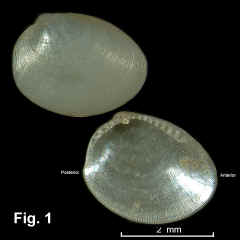|
|
NUCULIDAE |
|
|
|
Nucula pusilla Angas, 1877 Description: Shell relatively small for family. Shape equivalve, quite variable intraspecifically but always inequilateral with umbones situated well behind midline, somewhat inflated; anterior end broadly rounded; anterior dorsal margin slightly raised, posterior end broadly truncate; umbones rounded, low, hardly projecting above hinge line. Hinge taxodont with strong teeth, with up to 10 anterior and 4 posterior teeth. Chrondrophore oblique. Interior nacreous, silvery, with numerous, fine radial striae ending in fine crenulations at ventral margin. Exterior appears smooth but possesses concentric growth striae, sometimes crossed with fine radial striae, particularly posteriorly. Periostracum greenish brown. Exterior shell colour white. Size: Up to 4.5 mm in length. Distribution: Endemic to Australia: Newcastle, NSW, southwards and around southern Australia, including Tas, and northwards along WA coast to Montebello Islands. Habitat: From beach wash-up down to 164 m. Synonymy: According to WoRMs (2020), the established synonyms are Nucula micans Angas, 1879, Nucula minuta Tenison-Woods, 1876 (a junior homonym of Nucula minuta Owen, 1844, so replaced by Nucula hedleyi Pritchard & Gatliff, 1904) and Pronucula concentrica Cotton, 1830. Comparison: Nucula pusilla is the second most common species of the Nuculidae in NSW, after the much larger Ennucula obliqua. Remarks: Apparently this species is variable in sculpture, ranging from completely smooth to strongly radially and/or concentrically grooved. The figured specimen is strongly concentrically ribbed, with weak radial sculpture on the posterior end. Fig. 1: Bottle and Glass Rocks, Sydney Harbour (C.364574)
|
|
